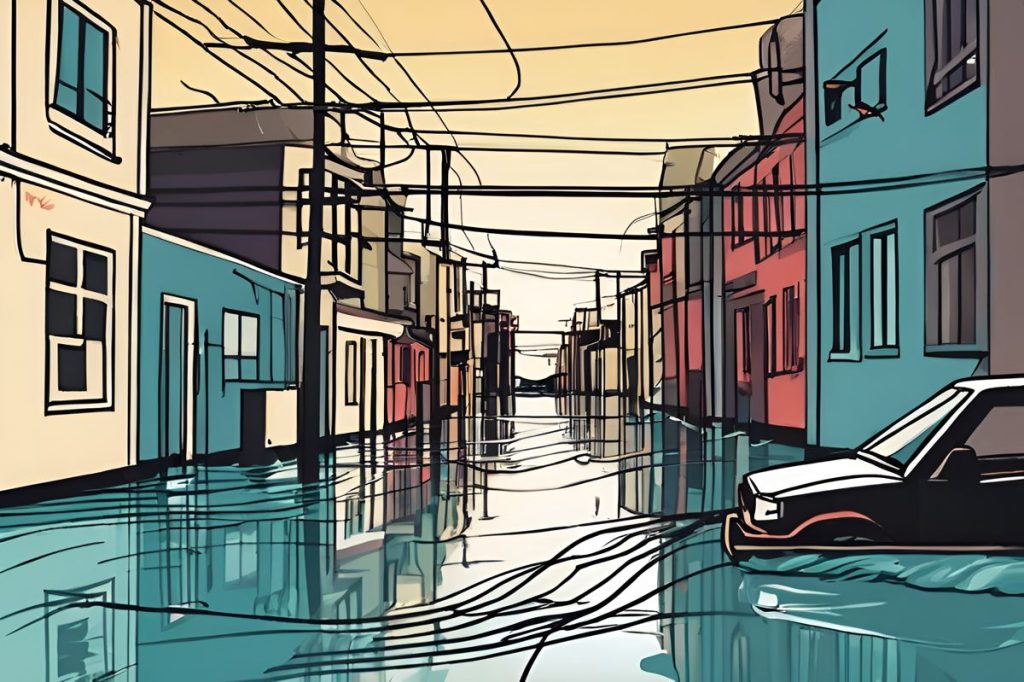In the heart-wrenching flood of Izmir on July 12, 23-year-old medical student Ozge Ceren Abi tragically lost her life to electrocution while crossing a flooded street, alongside a brave man named Inanc Oktemay who attempted to save her. As legal proceedings unfold, the incident has exposed grave oversights, revealing that electrical cables were dangerously shallow at just 30 centimeters underground instead of the required 80, prompting outrage and calls for accountability within the community.
What led to the electrocution incident in Izmir?
The electrocution incident in Izmir was caused by floods that made streets a conduit for electric currents due to improperly secured and insufficiently insulated electrical cables. Cables were not buried deep enough, being only 30cm underground instead of the required 80cm, leading to the tragic deaths of two individuals.
An Unfortunate Tragedy
In the bustling Aegean city of Izmir, a court case began recently, shedding light on a heart-wrenching event that took the life of Ozge Ceren Abi, a 23-year-old Cypriot medical student. The incident occurred amidst a flood on July 12, which led to the tragic electrocution of Abi as she attempted to cross a flooded road. The flood revealed underlying dangers as it became a conduit for a fatal electrical current due to improperly secured electrical cables.
Abi was not the only victim; a 44-year-old man named Inanc Oktemay also lost his life in a courageous attempt to assist her. This devastating event prompted an investigation that resulted in the arrest of 42 individuals. A key point of contention is the allegation that the electrical cables under the street were neither buried deep enough underground nor sufficiently insulated, contributing to the hazardous conditions that ensued when the streets were inundated.
Engineering Oversights and Legal Ramifications
The severity of the oversight became apparent when the mayor of Izmir’s Konak borough, Nilufer Cinarli Mutlu, pointed out post-incident that regulations require cables to be at least 80 centimeters underground. However, in this case, they were a mere 30 centimeters below the surface. Moreover, Turkey’s chamber of electrical engineers indicated an “insulation error” from the transformer stations to the distribution panel on the street, a defect believed to have directly caused the loss of life.
In the wake of the tragedy, Ahmet Abi, Ozge Ceren Abi’s father, voiced his grief and desire for justice outside the courtroom. He expressed a strong wish for those responsible to be held accountable to the fullest extent. This sentiment was echoed by Erhan Arikli, the ‘transport minister’ from the north, who after meeting with Izmir’s chief public prosecutor, underscored the repeated complaints made about the street’s safety. Previous warnings had been starkly highlighted in the media as well, with a local newspaper headline from 2019 prophetically asking, “Does someone have to die for this to be solved?”
A Community in Mourning
The community’s response has been one of shock and mourning. The loss of a young student in the prime of her life, coupled with the death of a man who selflessly tried to help, has resonated deeply. The court case is being closely watched by many who seek closure and demand improvements to ensure such avoidable tragedies are not repeated in the future. The incident has also thrown a spotlight on infrastructure safety and the importance of rigorous maintenance and adherence to safety regulations.
Public sentiment has also been fueled by reports of previous alarms raised about the safety of the area, including concerns directed at the Gediz Electricity Distribution company. These reports suggest that the tragedy might have been prevented if earlier warnings had been heeded.
In a world where the safety and well-being of citizens should be paramount, the unfolding legal proceedings in Izmir are a grim reminder of the consequences when adequate precautions and responsible infrastructure management are not prioritized. As the trial progresses, it stands as a stark lesson for cities around the globe to vigilantly maintain and inspect their urban environments to protect against such needless tragedies.
FAQ on the Electrocution Incident in Izmir
What led to the electrocution incident in Izmir?
The electrocution incident in Izmir occurred during severe flooding on July 12, 2023, when streets became dangerously electrified due to improperly secured and insufficiently insulated electrical cables. These cables were buried only 30 centimeters underground, far below the required depth of 80 centimeters, resulting in the tragic deaths of medical student Ozge Ceren Abi and her would-be rescuer, Inanc Oktemay.
What are the legal ramifications following the incident?
Following the tragic events, legal proceedings have begun, resulting in the arrest of 42 individuals connected to the alleged infrastructure failures. The investigation has highlighted serious oversights, including insufficient burial depth of electrical cables and insulation failures. The community is calling for accountability and justice for the victims, with the court case being closely monitored for its implications on infrastructure safety regulations.
How has the community responded to the incident?
The community has reacted with shock and mourning at the loss of Ozge Ceren Abi and Inanc Oktemay. Many locals are expressing outrage over the preventable nature of the tragedy and have rallied for improved safety measures. Previous complaints regarding the area’s safety, particularly directed at the Gediz Electricity Distribution company, have added to public sentiment, emphasizing the need for urgent infrastructure improvements to prevent similar incidents in the future.
What lessons can be learned from the Izmir tragedy?
The Izmir tragedy serves as a sobering reminder of the critical importance of rigorous safety regulations and infrastructure maintenance. It highlights the need for cities to heed community warnings and invest in adequate safety measures to protect their citizens. The incident underscores the responsibility of authorities to ensure compliance with established safety standards and to prioritize the well-being of the community to avert avoidable tragedies.

